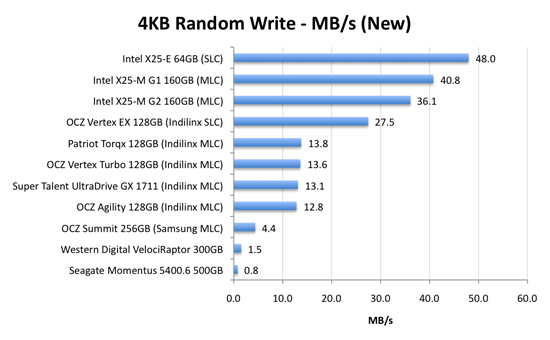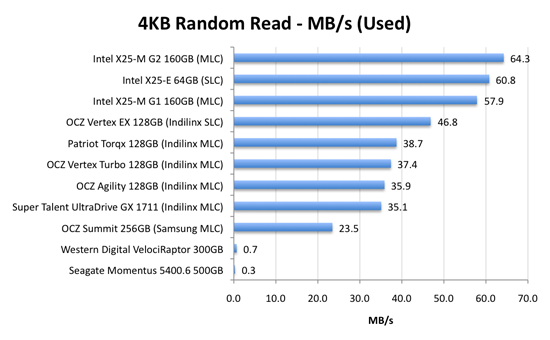The SSD Relapse: Understanding and Choosing the Best SSD
by Anand Lal Shimpi on August 30, 2009 12:00 AM EST- Posted in
- Storage
Random Read/Write Speed
This test writes 4KB in a completely random pattern over an 8GB space of the drive to simulate the sort of random writes that you'd see on an OS drive (even this is more stressful than a normal desktop user would see). I perform three concurrent IOs and run the test for 3 minutes. The results reported are in average MB/s over the entire time:

As we established in previous articles, the disk operations that feel the slowest are the random small file reads and writes. Both of which are easily handled by an SSD. A good friend of mine and former AnandTech Editor, Matthew Witheiler, asked me if he'd notice the performance improvement. I showed him the chart above.
He asked again if he'd notice. I said, emphatically, yes.

Now this is super interesting. Intel's X25-M G1 drops from 40.8MB/s when new down to 26.3MB/s in a well used state. Unfortunately for the G1, it will never get TRIM and will spend more time in the lower performance state over the life of the drive. But look at what happens with the X25-M G2: it drops from 36.1MB/s to 35.8MB/s - virtually no performance is lost. In fact, the G2 is so fast here that it outperforms the super expensive X25-E. Granted you don't get the lifespan of the X25-E and the SLC drive should perform better on more strenuous random write tests, but this is a major improvement.
The explanation? It actually boils down to the amount of memory on the drive. The X25-M G1 had 16MB of 166MHz SDRAM on-board, the G2 upped it to 32MB of slower 133MHz DRAM. Remember that Intel doesn't keep any user data in DRAM, it's only used for the remapping, defragmenting and tracking of all of the data being written to the drive. More DRAM means that the drive can now track more data, which means that even in the heaviest of random-write workloads you could toss at it on a normal desktop you will not actually lose any performance with the drive in a used state. And this is the drive Intel has decided to grant TRIM to.
The G2 is good.
The Indilinx drives do lose performance here. They drop from roughly 13MB/s down to 7MB/s. We're still talking ~5x the speed of a VelociRaptor, so there's no cause for alarm. But it's clear that even Indilinx's SLC drive can't match Intel's random write performance. And from what I hear, Intel's performance is only going to get better.
This is what the X25-M price premium gets you.

Bahahaha, look at the hard drive scores here: 0.7MB/s and 0.3MB/s? That's freakin' terrible! And that's why your system feels so slow when you start it up, there are a ton of concurrent random reads and writes happening all over the place which your hard drive crunches through at roughly 0.5MB/s. Even the Samsung based OCZ Summit manages a significant performance advantage here.
The Indilinx drives all cluster around the 30 - 40MB/s mark for random read performance, nothing to be ashamed of. The Intel drives kick it up a notch and give you roughly 60MB/s of random read performance. It's a noticeable improvement. As our application launch tests will show however, loading a single app on either an Indilinx or Intel drive will take about the same amount of time. It's only in the heavy multitasking and "seat of the pants" feel that you'll have a chance at feeling a difference.










295 Comments
View All Comments
Anand Lal Shimpi - Monday, August 31, 2009 - link
wow I misspelled my own name :) Time to sleep for real this time :)Take care,
Anand
IntelUser2000 - Monday, August 31, 2009 - link
Looking at pure max TDP and idle power numbers and concluding the power consumption based on those figures are wrong.Look here: http://www.anandtech.com/cpuchipsets...px?i=3403&a...">http://www.anandtech.com/cpuchipsets...px?i=3403&a...
Modern drives quickly reach idle even between times where the user don't even know and at "load". Faster drives will reach lower average power because it'll work faster to get to idle. This is why initial battery life tests showed X25-M with much higher active/idle power figures got better battery life than Samsungs with less active/idle power.
Max power is important, but unless you are running that app 24/7 its not real at all, especially the max power benchmarks are designed to reach close to TDP as possible.
Anand Lal Shimpi - Monday, August 31, 2009 - link
I agree, it's more than just max power consumption. I tried to point that out with the last paragraph on the page:"As I alluded to before, the much higher performance of these drives than a traditional hard drive means that they spend much more time at an idle power state. The Seagate Momentus 5400.6 has roughly the same power characteristics of these two drives, but they outperform the Seagate by a factor of at least 16x. In other words, a good SSD delivers an order of magnitude better performance per watt than even a very efficient hard drive."
I didn't have time to run through some notebook tests to look at impact on battery life but it's something I plan to do in the future.
Take care,
Anand
IntelUser2000 - Monday, August 31, 2009 - link
Thanks, people pay too much attention to just the max TDP and idle power alone. Properly done, no real apps should ever reach max TDP for 100% of the duration its running at.cristis - Monday, August 31, 2009 - link
page 6: "So we’re at approximately 36 days before I exhaust one out of my ~10,000 write cycles. Multiply that out and it would take 36,000 days" --- wait, isn't that 360,000 days = 986 years?Anand Lal Shimpi - Monday, August 31, 2009 - link
woops, you're right :) Either way your flash will give out in about 10 years and perfectly wear leveled drives with no write amplification aren't possible regardless.Take care,
Anand
cdillon - Monday, August 31, 2009 - link
I gather that you're saying it'll give out after 10 years because a flash cell will lose its stored charge after about 10 years, not because the write-life will be surpassed after 10 years, which doesn't seem to be the case. The 10-year charge life doesn't mean they become useless after 10 years, just that you need to refresh the data before the charge is lost. This makes flash less useful for data archival purposes, but for regular use, who doesn't re-format their system (and thus re-write 100% of the data) at least once every 10 years? :-)Zheos - Monday, August 31, 2009 - link
"This makes flash less useful for data archival purposes, but for regular use, who doesn't re-format their system (and thus re-write 100% of the data) at least once every 10 years? :-)"I would like an input on that too, cuz thats a bit confusing.
GourdFreeMan - Tuesday, September 1, 2009 - link
Thermal energy (i.e. heat) allows the electrons trapped in the floating gate to overcome the potential well and escape, causing zeros (represented by a larger concentration of electrons in the floating gate) to eventually become ones (represented by a smaller concentration of electrons in the floating gate). Most SLC flash is rated at about 10 years of data retention at either 20C (68F) or 25C (77F). What Anand doesn't mention is that as a rule of thumb for every 9 degrees C (~16F) that the temperature is raised above that point, data retention lifespan is halved. (This rule of thumb only holds for human habitable temperatures... the exact relation is governed by the Arrhenius equation.)Wear leveling and error correction codes can be employed to mitigate this problem, which only gets worse as you try to store more bits per cell or use a smaller lithography process without changing materials or design.
Zheos - Tuesday, September 1, 2009 - link
Thank you GourdFreeMan for the additional input,But, if we format like every year or so , doesnt the countdown on data retention restart from 0 ? or after ~10 year (seems too be less if like you said temperature affect it) the SSD will not only fail at times but become unusable ? Or if we come to that point a format/reinstall would resolve the problem ?
I dont care about losing data stored after 10 years, what i do care is if the drive become ASSURELY unsusable after 10 year maximum. For drives that comes at a premium price, i don't like this if its the case.